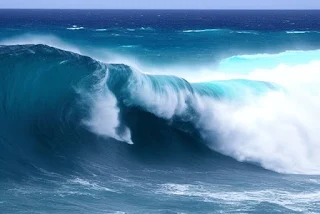Under Ocean Currents - Part 1, Ocean Current Stream & its Origin, we learned about the origin of ocean currents and their types. Under Ocean Current - Part 2 , Atlantic Ocean Currents, we learned about the Atlantic Ocean Currents. Under Ocean Current - Part 3, Pacific Ocean Currents, we will learn about the Pacific Ocean Currents. We will study the world mainly by dividing it into three regions, Whose brief details are given below –
- Ocean Current - Part 1, Ocean Current Stream & its Origin
- Ocean Current - Part 2 , Atlantic Ocean Currents
- Ocean Current - Part 3, Pacific Ocean Currents
- Ocean Current - Part 4, Indian Ocean Currents, Effect and Importance of Currents
Pacific Ocean Currents
Pacific Ocean is surrounded by America, Australia, New Zealand, Philippines, Japan, China etc. We will also understand the Pacific Ocean currents by the water currents of the Northern Hemisphere and the Southern Hemisphere as per convenience.
A . Water Currents of the Northern Hemisphere
B. Water Currents of the Southern Hemisphere
Statue of EqualityA . Water Currents of the Northern Hemisphere
- North Equatorial Current (warm current)
- Kuroshio current (warm current)
- Kurile Current or Oyoshiwa Current (cold current)
- Tsushima Current (Warm Current)
- North Pacific Current (warm current)
- Alaska Current (Warm Current)
- California Current
1. North Equatorial Current (warm current)
Due to the high temperature near the equator, the water gets heated and is carried away by the trade winds. This current starts from the west coast of Central America and flows from east to west till the Philippines Islands.
2 . Kuroshio current (warm current)
Due to the influence of trade winds near the Philippines Islands, the North Equatorial Current turns north and runs along the east coast of south central China, Taiwan and Japan. Here it is called Kuroshio Current. Due to its deep blue color on the coast of Japan, the Japanese people call it the 'Black Stream of Japan'. Moving forward from here, it joins the cold current called Kurile.
3. Kurile Current or Oyoshiwa Current (cold current)
It starts from the Sea of Okhotsk and flows south along the coast of Siberia, passing through the Bering Strait. Proceeding from here, it joins the Kuroshivo warm current near Hokkaido island of Japan, which causes dense fog here. This place is a vast area for fish collection.
Topographies Formed By Underground Water4. Tsushima Current (Warm Current)
Near the Japan Islands, a part of the Kuroshivo Current separates from Kuroshivo Island and starts flowing from Japan to South Korea, which is called the Tsushima Current.
5. North Pacific Current (warm current)
When the Kuroshivo current moves forward after meeting the Kurile current, it moves towards the east due to the influence of the westerly winds. Here the expansion of this stream becomes very much, which is called the North Pacific Current. It gets divided into two parts after reaching the coast of North America. Out of these, one branch moves towards the north while the other branch flows towards the south.
6. Alaska Current (Warm Current)
After the division of the above-mentioned North Pacific Current on the coast of America, one branch of them flows towards the north and enters the Gulf of Alaska and moves along the coast of Alaska. This is called the Alaska Current.
7. California Current
The second branch of the North Pacific Current turns south and runs along the coast of California, which is called the California Current. From here, it joins the North Equatorial Current in the south.
Carbon Footprint : Impact and PreventionB. Water Currents of the Southern Hemisphere
- South Equatorial Current (warm current)
- New Guinea Current (warm current)
- East Australia Current or New South Wales Current (warm current)
- South Pacific Current or Antarctica Current
- Peru or Peruvian or Humboldt Current (cold current)
- El - Nino Current

Comments
Post a Comment